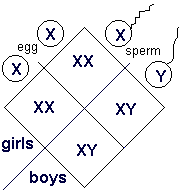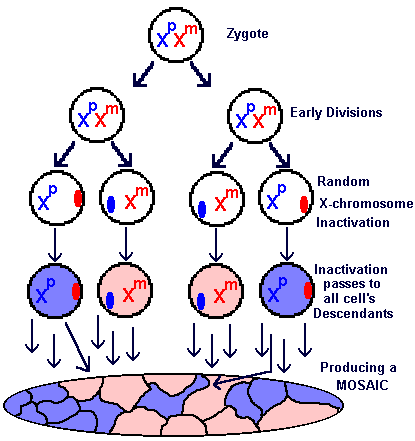
|
Student's Study Guide for Lesson Twelve
by Dr Jamie Love |

|
 and
and  licensed under a Creative Commons Attribution-ShareAlike 4.0 International License.
licensed under a Creative Commons Attribution-ShareAlike 4.0 International License.

|
Student's Study Guide for Lesson Twelve
by Dr Jamie Love |

|
Sex is determined in different ways depending upon the ____.
Many plants and some animals (__________ and hydra) have both male and female sex organs in the same individual and produce both male and female gametes (sperm and egg, respectively). These organisms are __________.
[In Greek monoecious means "___ house".]
In animals we use the word _____________. There is no difference among the sexes because each individual is both sexes. To them, sex is just an extra _____ system.
Dioecious organisms come in two sexes, ____ and ______, and each individual will produce only one type of gamete.
[In Greek dioecious that means "___ houses".]
Among some dioecious taxa (some species of fish, alligators and sea turtles) sex is determined by the _________, not genetics. Local concentrations of ______ or differences in __________ will cause the developing embryo to develop as either a male or a female.
The sex of most dioecious species is determined by ________.
_______ have evolved some unusual sex determining systems.
In most dioecious taxa the sex is determined by specific ___ ___________.
Most animals have a pair of sex chromosomes and, together or individually (depending on the taxa), these determine the sex of the developing ______ and thus the sex of the fully grown individual.
The XY system of sex determination applies to all _______ and several other taxa, but not all taxa. Birds, butterflies, some reptiles and some fish use a sex determination system called the "__ system" in which everything is "backwards".
We have __ chromosomes or 23 pairs of chromosomes.
22 _____ __________ pairs (chromosomes that share the same genes at the same loci). Those chromosomes are not involved in sex determination and are called _________. They form the familiar tetrads at meiosis I.
The 23rd pair of human chromosomes is NOT homologous, at least not in men.
All male mammals have one _ chromosome and one _ chromosome. These are the sex chromosomes and they are ___ homologs. They do not share any loci or _____.
Female mammals do not have a Y chromosome. Women have ___ X chromosomes.
So, we have 22 pairs of autosomes (numbered from the largest #1 to the smallest #22) and one pair of sex chromosomes. Among the sex chromosomes, men have XY and women have XX.
At a particular position on the Y chromosome is a gene called the "sex ___________ region on the Y" or simply "SRY", responsible for turning a mammalian embryo into a ____ mammal.
We are genetically "pre-programmed" to become ______.
SRY begins a developmental "cascade" in which other _____, many of them on autosomes, are also turned on.
SRY starts a development _______ producing male features in the embryo.
Embryos without a Y chromosome continue in their default pathway to produce ______ features in the embryo.
|
A Punnett square for sex determination using the sex chromosomes.
The female produces only one type of egg with respect to ___ chromosomes.
|

|
__________ among the sex chromosomes is more common than autosomal aneuploidy. Aneuploidies come about due to errors in meiosis during the gamete formation in one of the parents so the zygote starts out with the wrong chromosomal count.
Klinefelter syndrome a person has two _s and one Y.
XXY and has a total of __ chromosomes
What would be this person's sex?
[____]
There are rarer variations of Klinefelter syndrome in which the individual has even ____ extra Xs (Like XXXY and XXXXY.)
The "opposite" sex chromosome aneuploidy would be to have more than ___ Y chromosome.
These XYY people are male, and this condition is ___ ________. These men do not have an abnormal phenotype.
YY and YO are _____.
We all must have at least one _ chromosome to survive.
_______ X is a condition where the woman has three Xs, so she has a total of 47 chromosomes. There are rarer variations on this aneuploidy in which a woman has four or five extra X chromosomes! With each extra X the mental retardation becomes more ______.
Women with Turner syndrome have only __ X chromosome. This is the only (viable) human aneuploidy involving less than __ chromosomes.
The Y chromosome is the _______ chromosome and it is made mostly of useless "____ DNA". The only gene it carries (of any importance) is ___.
The X chromosome is one of the _______ chromosomes and it is packed with very important genes.
Genes on the X chromosome are said to be _-linked and they present us with a very special puzzle.
There are (roughly) _____ amounts of gene products (proteins) from X-linked genes in men and women.
Women avoid being "over dosed" by turning ___ one of their X chromosomes in a process called X inactivation. Which X chromosome they turn off is determined ________ during embryo development.
|
Early in __________ the X chromosomes are randomly inactivated in each cell. In any particular cell it could be the paternal (X_) or the ________ (Xm) that remains active.
The inactivated X chromosome becomes a tiny blob of dense, useless _________ called the Barr body (shown here as a dark oval). These cells pass their inactivation patterns to all their ___________. The embryo, and the organism it becomes, is a mixture of ___ types of cells. We call such an organism, a ______ (because it is like each cell contributes a "tile" to make the final "image"). X inactivation allows for a ______ compensation and explains the mosaicism seen in _____ of heterozygous female mice and cats.
Females that are heterozygous for X-linked genes are mosaic for those genes and, therefore, are not "truly" heterozygotes on a ____-to-____ basis.
|

|